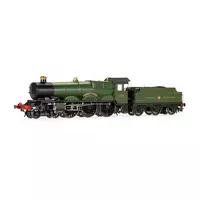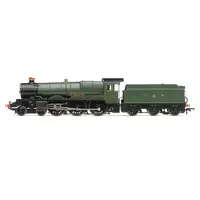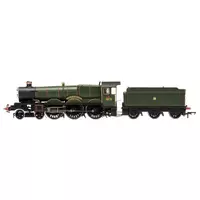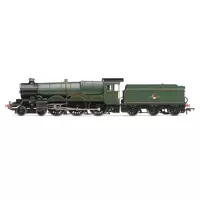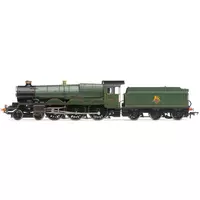Manufacturer catalogue image - please note that pre-release images may be CAD renders or CGI images rather than photographs
Prototype Era
Era 3 (1923 to 1947) The Big Four (LNER, LMS, GWR and SR)
Manufacturer description
The Castle Class was designed by Charles Collett, the successor to legendary GWR engineer George Jackson Churchward. In truth, Castle Class is nothing more than a nickname owing to most examples of the class being named after western castles with the official GWR designation being the 4073 class.
This name comes from the first example of the Class 4073 Caerphilly Castle, as was common with GWR classes. Charles Collet improved on the work of Churchward with the Castle Class, with the class proving to be among the most powerful on the GWR network. In a tragic twist of fate, Churchward would go on to be killed when struck by one of the succeeding engineers locomotives 4085 Berkeley Castle.
The first of the class would feature at the British Empire Exhibition in 1924 alongside an equivalent engine from the LNER, one 4472 Flying Scotsman. Over the course of the exhibition the GWR claimed their Castle to be more powerful than the LNER contingent, leading to exchange trials between the GWR and image conscious LNER. In April 1925 4079 Pendennis Castle and 4474 Victor Wild would be exchanged between the two companies.
The Castle Class was lighter than the LNER pacific which proved to be an unexpected positive as the LNER found it still capable of hauling their express services doing so faster and more efficiently than their locomotives of the time. Conversely, the GWR found the LNER locomotive to have too long a wheelbase for their rails, hampering is performance on the twisting and winding curves of the western region.
4073 Caerphilly Castle was the first of the Class to be built and was a bespoke example, not a rebuild of a Star Class. The locomotive was built in August of 1923 and would go on to serve into BR days finally being withdrawn in May 1960 making it one of the earliest seven of the class to be withdrawn. As the first of the class, the locomotive has been preserved and can be found on display at Swindon Steam Museum, close to where it was built some 100 years ago.
The Hornby Castle class is fitted with a five pole motor and simple mechanism resulting in fantastic performance. DCC users are catered for via an 8 pin socket inside the tender with space for a speaker to be fitted.
Produced under licence for SCMG Enterprises Ltd. © SCMGE. Every purchase supports the museum.
Catalogue listing
Model details
Prototype information
* Class names often change over the lifespan of a locomotive, so this is not necessarily the class name used by the operator in the period modelled.
Supplier links are provided for your convenience and do not guarantee that the product is currently available. RailwayModels.uk is not a representative of these suppliers, but may receive a commission when purchases are made through links on this page.

